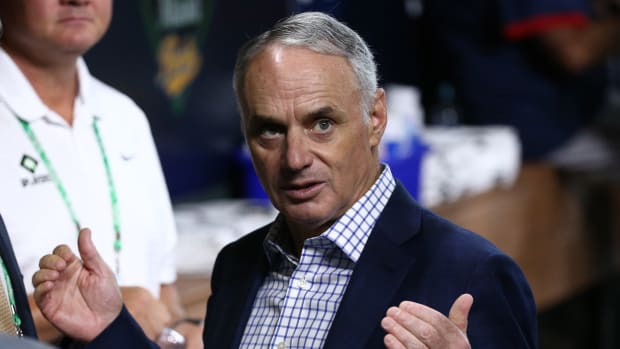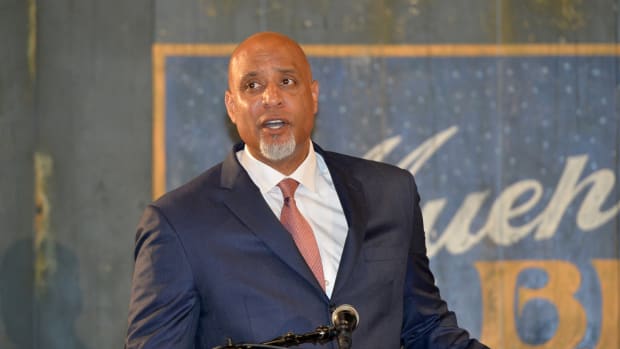Lockout Watch: Why Players Are Standing Firm After MLB's Move for Mediation - Column
It was always going to get uglier before it gets better.
What was originally a sound expectation for baseball's ninth work stoppage now sounds like an optimist's plea for a punctual start to the 2022 season. No, the sky isn't falling on the baseball world just yet, but the forecast is growing more and more dim by the day.
Major League Baseball (MLB) on Thursday formally requested for federal mediation in collective bargaining sessions. One day later, the MLB Players Association (MLBPA) rejected the proposal—which is within the union's right—and issued the following statement:
“Two months after implementing their lockout, and just two days after committing to Players that a counterproposal would be made, the owners refused to make a counter, and instead requested mediation.
"After consultation with our Executive Board, and taking into account a variety of factors, we have declined this request.
“The clearest path to a fair and timely agreement is to get back to the table. Players stand ready to negotiate.”
MLB responded hours later with a statement of their own:
"Our goal is to have players on the field and fans in the ballparks for Spring Training and Opening Day. With camps scheduled to open in less than two weeks, it is time to get immediate assistance from the Federal Mediation and Conciliation Service to help us work through our differences and break the deadlock. It is clear the most productive path forward would be the involvement of an impartial third party to help bridge gaps and facilitate an agreement. It is hard to understand why a party that wants to make an agreement would reject mediation from the federal agency specifically tasked with resolving these disputes, including many successes in professional sports. MLB remains committed to offering solutions at the table and reaching a fair agreement for both sides."
This comes just a few days after the two sides met at the bargaining table, which was described as a "yelling match" by a source with knowledge of the negotiations. In the meeting, MLB initially told the MLBPA that it would counter the union's proposal and also said it was considering mediation. According to The Athletic, a league source said MLB's interest in mediation was "in earnest", but the players have scoffed at the move, chalking it up as a PR stunt.
Two days later, the league informed the union they were not going to offer a counterproposal and requested permission for mediation.
Not only did Max Scherzer—who is on the union's executive committee—speak out against MLB in Tuesday's meeting, he also took to Twitter to explain the union's frustration with negotiations and why mediation is, in their view, unnecessary.
“We don’t need mediation because what we are offering to MLB is fair for both sides," Scherzer tweeted. "We want a system where threshold and penalties don’t function as caps, allows younger players to realize more of their market value, makes service time manipulation a thing of the past, and eliminate tanking as a winning strategy."
Progress between the two sides has been minimal to this point. MLB and the MLBPA agree the league's minimum salary needs to be raised and pre-arbitration players need to be better compensated, but are drastically far apart on dollars. While the players have given up their fight for earlier free agency and the league has conceded on their effort to replace the salary arbitration system with a formula-based model, the Competitive Balance Tax remains a colossal hurdle and will likely be the key domino to fall before a new CBA is agreed upon.
Throughout negotiations, the union has made more proposals on the CBT while the league has either moved incrementally or completely ignored it in its proposals.

With little movement after a couple weeks of negotiations, MLB opted to call for mediation. The move immediately put the MLBPA in a lose-lose situation. Either the union accepts and risks losing on making real change or rejects and the league has plausible deniability with the public.
Remember what MLB's statement read?
"...It is hard to understand why a party that wants to make an agreement would reject mediation from the federal agency specifically tasked with resolving these disputes, including many successes in professional sports..."
The National Hockey League's lockout in 2012-13 was resolved with the help of federal mediation, and some argue it saved the season, though it was reduced from the standard 82-game schedule down to 48. MLB could very well point to that and say, "See? Federal mediation could lead to an on-time start to the season and the players rejected it!"
The problem is comparing MLB to other professional sports leagues in North America. The National Football League and NHL both have a hard salary cap. The National Basketball Association operates with a soft cap. Major League Baseball has no cap, but its CBT threshold has become an unofficial cap for most clubs.
It's crucial to note that salary caps come with a salary floor. Teams in the NFL, NHL and NBA can't spend past a set threshold, but they have to spend over a certain minimum. Since MLB doesn't have an official salary cap, there is no salary floor. So what happens when the vast majority of clubs treat the CBT threshold like a cap and there is little accountability for those at the bottom to reinvest revenues on the field? That's the question players are fervently trying to address in these negotiations.
MLB has offered a salary floor during these negotiations, but with it came a reduction of the CBT threshold from $210 million down to $180 million—a number it hasn't been since after the 2013 season when it rose from $178 million in 2013 to $189 million for the 2014, 2015 and 2016 seasons. The union swiftly rejected the offer, knowing it would significantly hamper the free agent market. Contracts like the 10-year, $325 million deal Corey Seager just signed with the Texas Rangers would likely become a thing of the past under this type of structure.

Regardless of how you personally believe dollars should be divided between the owners and the players, the latter has a better track record in these negotiations on addressing the integrity of the game. In terms of discouraging clubs from tanking, the MLBPA has made greater efforts to combat it with their proposals.
In a proposed draft lottery, which has been offered by both side, the players have consistently offered more teams in the lottery, which would discourage clubs from tanking toward a higher slot in the draft.
After losing ground in the past two CBAs and watching the average salary drop in the past four full seasons, the union is poised to make significant change. That wasn't going to come without a fight. It was widely expected for the owners to challenge the players' resolve, even threatening them with the real possibility of losing paychecks. Now MLB has played one of its biggest PR cards, knowing the players would reject mediation, which makes them look like the bad guys in the eyes of the public.
Why don't players want mediation? A federal mediator was utilized during the infamous 1994-95 strike, and it was not viewed well by the union whatsoever. In 2019, Don Fehr, the head of the MLBPA during the strike, bashed the process, saying it was "a joke" that had "no value."
There are two notable differences between now and baseball's previous work stoppage. Social media wasn't around in the mid-90s. Players have a voice that isn't muddied or hindered by the media. It's plain, clear and accessible for anyone in the world and they have taken full advantage of this platform.
I know some of you fans aren’t happy with the lockout but THIS is what we’re dealing with 🤦🏼♂️ https://t.co/3ZgTaFXSLM
— Paul Sewald (@ItsPaulSewald) February 4, 2022
We’ve had Breakfast, Brunch, Lunch, Happy Hour, Apps, Dinner and Dessert we’ve been.. #AtTheTable https://t.co/7Qtd6WAScS
— Jose Trevino (@HipHipJose5) February 4, 2022
When attempting to negotiate a collectively bargained agreement… “bargaining” is required. #AtTheTable #StillWaiting https://t.co/NU08uInVME
— Zack Britton (@zbritton) February 4, 2022
If the goal is to get players on the field asap- then why did it take 43 days after the lockout to even hear from MLB? Didn’t seem like a priority then! Why did we not get a counter proposal this week? It’s all extremely tired antics/optics.
— Jameson Taillon (@JTaillon50) February 4, 2022
The second and most crucial note is this is a league-implemented lockout, not a strike by the players. Any threats of pushing back spring training or losing regular season games ultimately comes back on the owners. They can end the lockout at any moment, which would allow business to resume under the guidelines of the previous CBA. The owners won't do this because this happened in 1994-95, and the players ended up going on strike. This time, they took away the union's ability to do so with a lockout.
What really hurts the league's standing in all of this is some of the language in Rob Manfred's "letter to baseball fans" that came out minutes after the previous CBA expired and the owners unanimously voted to lock out the players.
"Simply put, we believe that an offseason lockout is the best mechanism to protect the 2022 season," Manfred said. "We hope that the lockout will jumpstart the negotiations and get us to an agreement that will allow the season to start on time."
He ended the letter with, "MLB is ready to work around the clock to meet that goal. I urge the Players Association to join us at the table."
The first meeting on the core issues that stand in the way of a new agreement, which laid at the feet of MLB, did not take place until six weeks after the letter was published. Even since negotiations have started, MLB has postured as negotiating in good faith, offering proposals that address the issues where the players want to see change, but have hardly budged on their stances. Then, when the players stand firm, the owners call for a third party.
"It's sad what this has come to when they didn't want to negotiate all those weeks before," one player told InsideTheRangers.com on the condition of anonymity.
Even with this round of negotiations at their lowest point, the start of the season is not yet lost. If March 1 comes and goes without a new agreement, Opening Day will be in serious peril.
The owners will have their quarterly meeting in Florida next week, and Manfred typically closes with a press conference. Union representatives will also be in Florida, giving the opportunity for more in-person meetings between the two sides.
Since the union made the last proposal, the ball is in MLB's court. The eyes of the baseball world will turn to Manfred when he addresses reporters next week. It goes without saying, but what the commissioner chooses to say after a contentious week between the two sides will come with intense scrutiny.
Make sure to like SI's 'Inside The Rangers' on Facebook
